- Submissions

Full Text
Integrative Journal of Conference Proceedings
Hydrothermal Veins and Not Hydrothermal Exhalations-Responsible for Deposition of Manganese Ores in the Precambrian Sausar Group of Rocks of Madhya Pradesh, India
Banerji DC*
Department of Geology, India
*Corresponding author: Banerji DC, Department of Geology, India
Submission: March 16, 2022;Published: April 21, 2022

Volume3 Issue1April, 2022
Abstract
Contrary to the general belief of a sedimentary origin for the manganese deposits associated with the Paleoproterozoic ‘Sausar Group’ of rocks of Madhya Pradesh, India, the evidences like-invariable association of shear zones, very glaring in satellite images, with all the manganese deposits of Madhya Pradesh; the ‘S-C’ fabric shown by the mineral constituents of the ore inter-bands; pinch and swell arrangement of the ore bodies; presence of tongues of ore bodies in wall rocks of Tirodi mines with swerving around foliation in host Tirodi biotite gneiss; and the co-axial but non coplanar relationship of the shear parallel manganese ore inter-bands with the S1 foliation of the host phyllite in Bharweli Mines; as encountered during the course of present work, is more supportive of igneous emplacement of the ore bodies within the ‘Sausar Group’ of rocks of diverse origin (granitic gneisses and meta-sedimentaries).
The affirmative ore petrography, as also detailed by earlier workers, indicate presence of high temperature ore minerals within the ore bodies exhibiting textures better suited for rocks of igneous origin. The ‘strain sensitive fabric’ exhibited by the constituent minerals of the ore bodies supports for a progressive ‘simple’ shear deformation within the shear zones hosting manganese ore deposits of Madhya Pradesh. The noncoplanar relationship of the Manganese ore inter-bands with the S1 schistosity of the country rock, their being coplanar to the shear planes, and co-folding of the ore bodies and the shear planes along S2 and S3 axial traces, points to the fact that the Sausar rocks were affected by co-axial (S1) but non coplanar shearing and hydrothermal emplacements, at the waning phase of the D1 deformation. Evidences of pneumatolysis along the flanks of such ore zones indicate igneous activity responsible for the metasomatic changes in mineral composition along the periphery of the Mn-oxide bearing hydrothermal emplacements.
Introduction
After the discovery of Manganese deposits associated with the Precambrian rocks of Sausar Group of Bhandara district by P.N.Dutta in 1893-94, it was Sir Fermor LL [1] who brought out a detailed account of Sausar rocks and the associated manganese ore deposits of Central India. As the ore bodies comprise mainly of high temperature manganese-oxide ores, Fermor (op. cit.) was of the opinion that the oxides have resulted, either from metamorphic alteration of original sedimentary manganese minerals, or from deep seated re-oxidation of the manganese silicates (Gondite). Straczek JA et al. [2], later, opined that the deposition of the manganese took place as primary manganese-oxide ‘braunite’, and was further metamorphically altered to high temperature manganese oxides, or metsomatically to manganese silicates (Gondite). Roy S [3], however, concluded that there was deposition of both impure and pure manganese sediments, which, by later metamorphic processes, got converted to Gondite, and to high temperature manganese ore bodies, respectively. It is important to note that, other than co-folding of the ore bands with the quartz-muscovite schists (Mansar Formation), colour bandings produced by alternate arrangement of manganese ore and the associated quartzose bands is the only direct field evidence favouring these deposits as syngenetic. Nayak BK et al. [4], nevertheless, after their all the samples collected from the major manganese mines of Madhya Pradesh plotted in the hydrothermal field of the “Mn-Fe-(Ni+Co+Cu) x 10” plot, considered the manganese deposits of Sausars as ‘hydrothermal exhalates’.
Manganese Mineralization and Host Rocks
The Paleoproterozoic gneiss and schist belt of the Sausar Group of Madhya Pradesh is known to host number of workable manganese deposits. The Sausar Group of rocks is divisible (after Narayanaswami S et al. [9]) into a basal Sitasaongi quartzmuscovite schist and gneiss Formation, followed, in ascending order, by Lohangi marble and calc-silicate/granulite/gneiss Formation, Mansar phyllite and muscovite schist/gneiss Formation, Chorbaoli quartz-muscovite schist/gneiss and quartzite Formation, Junewani biotite-muscovite schist/gneiss and biotite granulite Formation and the youngest Bichua marble and calc-silicate Formation. Naryanaswami et. al. (op.cit.) has considered the Tirodi biotite gneiss to be the basement for the Sausar Group and the contact between the two has been taken to be disconfirmable. Manganese mineralization, as oxides, is known to occur at bottom and middle horizon of Mansar phyllite and muscovite schist/gneiss Formation, and as silicates (Gondite) at the uppermost horizon (Narayanaswami S et al. [9] op.cit.). Also, minor manganese oxide deposits are reported from within the meta-carbonate rocks of Lohangi Formation (Roy S [3,10]).
It is not out of context to mention here that Banerji DC et al. [7,11], however, have contested the stratigraphic succession of the Sausars as ‘arbitrary’, reasoning that the Tirodi biotie gneiss is synkinematically emplaced into the pre-existing Sausar rocks, dominated by calcareous sediments, and metasomatically and/or metamorphically produced the rocks like metacarbonates (marble), calc-silicates/granulites, biotite granulites, biotite schists, and calcareous phyllite. An epigenetic emplacement of the manganese ores within structurally controlled weak zones is also proposed by them against the age old theory of deposition of sedimentary manganese.
Quartz-Manganese inter-bands of variable thicknesses constitute the deposits hosted within sericite-phyllite (Mansar Formation) in Ukwa and Bharweli, located at the eastern end of the manganese belt of Madhya Pradesh, India. The deposits of Ramrama, Tirodi and Sukli-Sitapathore, located further to the west, occur as narrow, repeated, bands hosted within ‘Tirodi biotite gneiss’, in close association with thin layers of quartz-mica schists. These biotite gneiss hosted deposits, therefore, are considered, in the available literature, to have deposited within long, narrow, depositional furrows formed within the basement ‘Tirodi gneiss’, lacking deposition of other members of the Sausar Group.
Meta-carbonate rocks of Sausar Group, hosting minor workable manganese oxide ore lenses are known from west of Tirodi and Sukli-Sitapathore deposits of Madhya Pradesh. Some of these lenses, like the one occurring 2.5km ESE of Dulhapur (210 42’ 00”: 790 36’ 45”), occupy the contact zone between meta-carbonates and the biotite gneiss. These meta-carbonate bands, however, are represented as belonging to Bichua Formation, in the existing geological maps.
Figure 1a: Geological sketch map of Sausar rocks of Balaghat-Seoni area (after Banerji DC et al. [6]).

Behavioural Pattern of the Ore Bodies
All the manganese ore deposits of Madhya Pradesh are represented in a characteristic pattern in the satellite images of the concerned areas. The Ukwa and Bharweli deposits, located at the eastern end of the manganese belt, are confined within a long and continuous, sinuous, shear zone extending between Ukwa in the east and Waraseoni to the west and further beyond, having an extension of more than 60km with an average width of about 0.6km, and referred to as Zone-I mylonite (Figure 1a) in the geological map of Banerji DC et al. [6].
Manganese ore, both in Ukwa and Bharweli deposits, occurs as lensoidal bodies, oriented parallel to the outline of the weak zone, and is easily recognised in satellite images as abandoned elongated pits. General trend of the shear zone, accommodating these two deposits, is NE-SW, and the warps along NW-SE axis is responsible for imparting a sinuous nature to it. Continuity of the ore lenses/ bands at Ukwa deposit (Figure 1b), located far east of the mylonite zone, is traceable for a length of about 8km, having pinch and swells along strike and repetition of the lenses across the strike, with variable width of phyllite partings. Individual ore lenses/bands measure a maximum of about few hundred meters along the strike, and the width is variable from fraction of a meter to about 10 meter. Sub-surface continuity of the ore bands at Ukwa, along shallow to moderate northerly dip, is known to vary greatly.
Figure 1B: Geological sketch map of Sausar rocks of Balaghat-Seoni area (after Banerji DC et al. [6]).
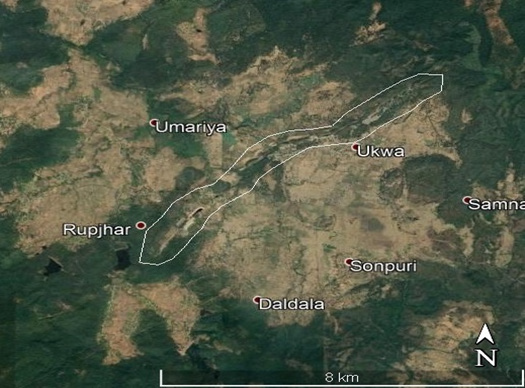
The ore bodies at Bharweli deposit (Figure 1c), located near Balaghat, however, are traceable for a length of about 3.5km as lenses/bands, restricted within the limits of the shear zone, exhibiting similar pattern of occurrence as that of in the Ukwa deposit. Ore lenses/bands are oriented parallel to the trend of the shear zone, with steep dips towards north.
Figure 1C: Satellite image showing part of the curvilinear mylonite zone extending from Waraseoni through Balaghat, Bharweli and beyond (not bordered for better perception).
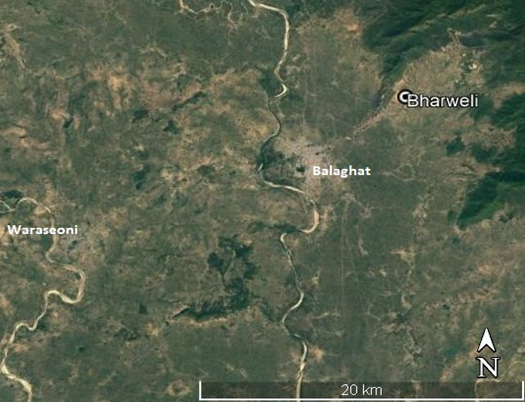
The Ukwa-Waraseoni mylonite zone also accommodates some other minor manganese occurrences like those - south of Laugur, Ghondi, and at Jagantola, located between Bharweli and Ukwa deposits. The ore bodies of Ramrama deposit (Figure 1d), located NW of Waraseoni, are similarly hosted within another NE-SW trending mylonite zone, having similar sinuous pattern of extension, later obliterated by repeated N-S faults. Ore bodies occur as lensoidal bodies, for some 3km, oriented parallel to the trend of the shear zone. The width of the shear zone is about 0.5km, and its further extension is obscured at either end because of thick alluvial cover.
Figure 1d: Satellite image showing curvilinear pattern of extension of ore zone at Ramrama.

Similar curvilinear pattern of extension of the ore bodies is noticeable in Tirodi, Sukli and Sitapathore deposits, located furher SW of Ramrama. The shear zone encompassing Tirodi deposit (Figure 1e) also has a general NE-SW trend and is traceable from Tirodi to Katangi and beyond, through Pauniya, Chaukhandi and Chikmara, traceable for more than 10km with an average width of 0.5km. Warping along NW-SE axis, imparting a sinuosity to the shear zone, also is a common phenomenon. Width of this weak zone is maximum at the southern end, having a tapering tendency towards north. This shear zone shows presence of ore lenses all through its length, thickest being around Tirodi.
Figure 1e: Satellite image showing curvilinear pattern of extension of ore zone from Tirodi to Katangi and beyond, through Pauniya, Chaukhandi and Chikmara.

It is interesting to note that the manganese deposits of Mansar and Kandri, located in adjoining state of Maharashtra, are also confined within a NW-SE trending sinuous belt (Figure 1f) affecting the Sausar rocks of the area. While the southern end of this curvilinear shear zone is narrow, the northern end near Kandri is dragged to east by a ENE-WSW trending fault. This shear zone also has an average width of about 0.5km and the ore lenses/bands are oriented parallel to the boundary of the shear zone.
It is amply clear from the study of images that the major manganese deposits are confined within one or the other shear zone of the area. The orientation of the shear zone is dependent on the regional structural set-up of the area. Curvilinear trend of the shear zones, in the satellite image, appears to be the result of later deformations. The ore lenses/bands present within the shear zones are oriented parallel to the boundary of the weak zones.
Figure 1f: Satellite image showing curvilinear pattern of Mansar – Kandri mylonite, from east of Khairi to Kandri.
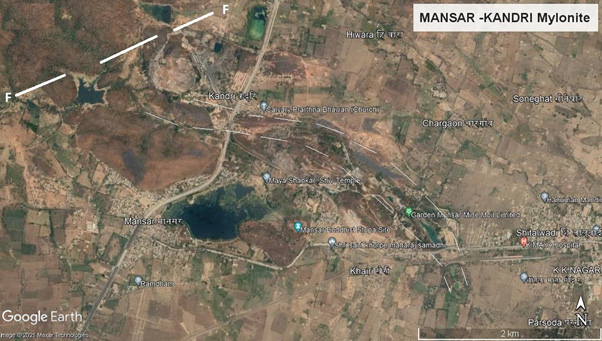
Field Relationship Between Host Rocks and the Ore Bodies
Phyllite hosted deposits
The NE-SW trending Ukwa-Waraseoni mylonite zone passes along the contact between Tirodi biotite gneiss (to south) and Mansar Phyllite (to north), and is traversed by numerous pink feldspar bearing pegmatites. Manganese mineralisation within this weak zone, however, is hosted within phyllite. Workable deposits of quartz-manganese inter-bands occur near Bharweli, south of Laugur, Ghondi, Jagantola and at Ukwa. At a few locations like at Gomji-Somji Pahar and at Gangulpara, meta-carbonate lenses are exposed in strike continuity of ore zone. Subsurface existence of meta-carbonate rocks are also known in strike continuity of the ore zone, west of Ukwa mines.
At many places, like west of Balaghat near Garra (210 48”:790 08”), in the Wainganga river near Balaghat (21o 49”:790 12”), east of Bharweli (210 50”:790 13”), and near Gangulpara (210 54”:790 17”), conglomeratic bands occur restrictively within this mylonite zone. Though, there is diversity of opinion about the origin of these conglomerates, Banerji et.al. [5,6,7], citing the invariable association of these conglomerates with the mylonite zone, considered them to be of crush origin. Incidentally, the conglomeratic horizons are also known to occur in vicinity of the manganese ore deposits of Ramrama, and along Mansar and Kandri deposits of the adjoining state of Maharashtra, obviously occurring restricted within the weak zone.
Figure 2a: Traces of shear planes (SH) within phyllite, hosting shear parallel manganese ore bands. Please note the superimposition of SH over S1, and of S2 cleavages over all the earlier planes. Loc. Bharweli Mines.

The Bharweli ridge exposes best section to study the interrelationship between the host phyllite and the inter-banded manganese ore bodies, along the footwall of a mined out manganese ore lens, located at the eastern edge of the Bharweli manganese mines. This paper presents the observations recorded from a freshly cut opening (Figure 2a) in the footwall, made for further underground activities. The footwall has alternating layers of quartz-manganese inter-bands alternating with bands of sericite rich Mansar phyllite. The strong pervasive foliation in phyllite, representing S1 schistosity planes, has a moderate (500-600) westerly dip, contrary to a steep (700-750) westerly dip of quartzmanganese inter-bands. While traces of the S1 foliation is not witnessed within quartz-manganese inter-bands, several Secondary Planes (SH), having parallelism with the steep manganese interbands, intersects the S1 foliation in phyllite.
The phyllite, in turn, is further intersected by shallow (300-400) westerly dipping planes. These shallow planes are continuous in nature, intersecting the S1 and SH planes present within phyllite, and also make their presence within the quartz-manganese interbands, imparting kinks to the inter-bands along these axial traces. These shallow planes, thus, represent S2 cleavage and witnessed as axial traces of the southerly plunging F2 folds involving all the entities like-Mansar phyllite, SH planes, and quartz-manganese inter-bands,- and strongly developed elsewhere (Figure 2b) in the same footwall.
Figure 2b: Co-folding of the quartz-manganese inter-bands (dark coloured) and the shear planes (SH) along S2 axial cleavages. Note the obliteration of S1 planes (stronger near right side margin) by overwhelming SH and S2 planes.

Incidentally, all these planes maintain a co-axial relationship with each other on the ground surface (Banerji DC et al. [5-7,11] Banerji DC [8]). The above narration clearly indicates that the ore inter-bands along with the shear planes (SH) are non-coplanar to S1 schistosity, though they maintain a co-axial relationship with each other on the ground surface. Also indicative is that the SH planes along with the ore inter-bands are post S1, and that the S2 planes produce kinks both on S1 and SH planes, being later to all the earlier planes. All these pre-existing planes and the ore bodies are further affected by F3 warping along NW-SE sub- vertical axis. Interference of F2 and F3 folds produces megascopic dome-basin structures, and pseudo ripples on mesoscopic scale (Figure 2c).
Figure 2c: Pseudo ripples produced by interference of F2 and F3 folds on intercalated Mn ore body. Please note that the above foot wall of the initial open cast mine, located at the eastern edge of the Bharweli ridge, which now has an opening for the underground work, provides best oppertunity to study the inter-relationship between host rocks and Mn mineralization.

The inter relationship between S1, SH and S2 planes, as discussed above, also holds true for Ukwa mines where northerly dipping S1 plane is very shallow (250-300) and the shear planes hosting manganese mineralization dip 350-400 in the same direction (Figure 2d). Traces of F2 folds and F3 warps, and the pseudo ripples produced by interference of these folds, are also prominent.
Figure 2d: Angular (non coplanar) relationship between S1 schistosity and shear planes (SH). Loc. Ukwa Mines.

Figure 2e: Pinching and swelling of Mn ore band within biotite gneiss. Loc. Northern end of Tirodi Mines. Also seen is the shear planes (in the lower half), synkinematically occupied by Mn-oxide bearing emplacements.
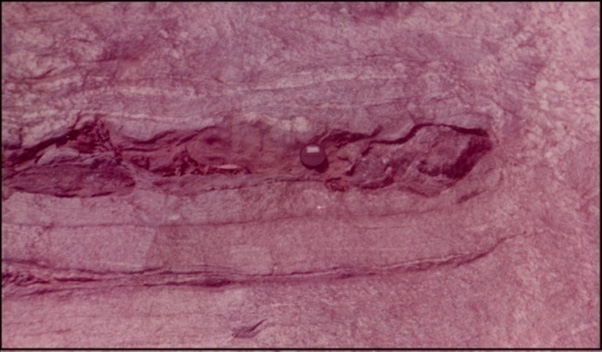
Biotite gneiss hosted deposits
In the biotite gneiss hosted manganese deposits of Ramrama, Tirodi and Sukli-Sitapathore, where the manganese is believed to have deposited in narrow furrows with thin envelope of quartzmica schists, the ore bodies exhibit pinch and swell nature and, at many a places, observed to have emplaced as tongues directly within biotite gneiss (Figure 2e). The pinch and swell nature of the ore bodies, with swerving around foliation of the host gneiss, is very clear towards lateral margins of the ore bodies, as seen in foot/hanging walls (Figure 2f) and also in strike extension, at the end part of the active mines.
Towards the end of the active mines, especially along the north-eastern extension of Tirodi and Sukli mines, the ore lenses become progressively lean, and extend for few kilometres in strike continuity, as evidenced by the presence of small left out pits, after winning the ore, all along the length of the shear zone identified in satellite image. Also noteworthy is the positive topography of the south-western end of the ore bearing zone (under active mining), getting peneplained to NE, with the reducing dimension of the ore bodies. Depth continuity of the ore lenses in such lean zones is traceable only for few meters, giving the impression of floating masses within biotite gneiss. This phenomenon holds true for all the biotite gneiss hosted manganese deposits of the area.
Figure 2f: Bulging of Mn ore bands within wall rock of felspathised biotite gneiss. Also, note the swerving around of the foliation at the periphery of ore lenses. Loc. Tirodi Mines.
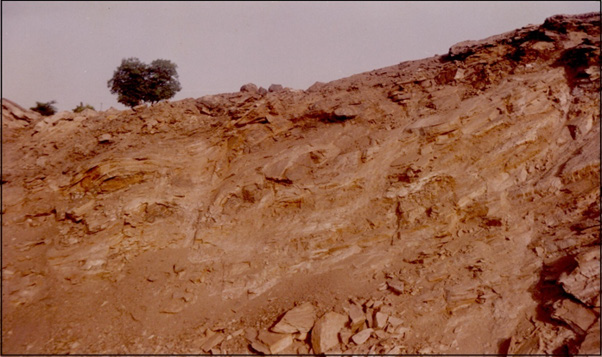
The Sukli-Sitapathore deposit extend for around 3kms with a sinuous trend and traceable as pods of 1m - 2m size within sheared and felspathised ‘Tirodi gneiss’ exposed in Dhoriya Nala (210 41’ : 790 41’). Similar habit is exhibited by the Tirodi ore deposit which extends for around 6kms, and splits into thin lenses, before final disappearance. Ramrama deposit, likewise, exhibits similar pattern and is further disturbed by later displacements along N-S trend. The ore bodies at these deposits also exhibit cross cutting relationship with the host biotite gneiss (Figure 2g).
Close association of calc-silicates with the biotite gneiss hosted deposits are also noteworthy. The manganese silicate rock ‘Gondite’ also makes a close association with the biotite gneiss hosted deposits. Sukli-Sitapathore deposit, present at the western extremity of the belt, exhibit best example of the association of calcsilicates, present as enclaves within the host biotite gneiss, and the ‘Gondites’ occupying the peripheral part of the ore lenses, having close proximity to the calc-silicate lenses. Banerji DC [8], based on the presence of plenty of manganese silicates within pegmatites crisscrossing the ore zone, and the invariable association of the calc silicates with the ‘gondites’ having enrichment of ‘Ca’ within manganese silicates, has advocated the possibility of participation of calc-silicates in the formation of ‘gondites’. He visualised the possibility of ‘gondite’ being a product of reaction between calcsilicates and manganese oxides, aided by the felspathic component available at the peripheral part of the manganese bearing hydrothermal fluids. The quartz inter-bands associated with the ore zones, in such cases, contain pockets rich in asbestos, obviously produced by the break-down of the amphiboles drawn from the calc-silicates.
Figure 2g: Cross cutting relationship of the Mn ore lenses (right hand corner) with the host biotite gneiss. Loc. Tirodi Mines.

General Characteristics of the Weak Zones Hosting Manganese Deposits
The manganese ore deposits of Sausar belt of Madhya Pradesh, as discussd above, thus, are intricately associated with the sinuous weak zones of considerable length (5km-60km or more) having an average width of 0.6km. The rock types affected by ENEWSW Ukwa-Waraseoni shear zone are biotitite gneiss, present to the south, and the northern Mansar phyllite having lenses of meta-carbonates within it. This weak zone also encompasses few conglomeratic horizons of doubtful origin, occurring near the contact between biotite gneiss and phyllite, at locations like Mohgaon (south-east of Bharweli Mines), Balaghat, and Garra; and within metacarbonates at Gomji-Somji Pahar and at Gangulpara. Banerji DC et al. [5-7,11] and Banerji DC [8], however, citing the occurrence of conglomeratic horizon within meta-carbonates, with stretched and rotated fragments of quartzo-felspathic material embedded within a calcareous matrix, and their restricted occurrence within the weak zone, have not favoured sedimentary origin for these conglomerates and advocated for a ‘crush’ origin. In their opinion, association of crush conglomerates, at number of places, within the Ukwa-Waraseoni shear zone, supports ductile nature of the shear zone. It is advocated that non co-axial movement along the shear zone has produced stretched pods and boudins of the numerously occurring, synkinematic, pink feldspar pegmatites, and have resulted in crush conglomerates. Lensoidal occurrence of the manganese ore bodies, also, is attributed to this phenomenon. Both, post and synkinematic quartz veins and pink feldspar bearing pegmatites occur abundantly within the weak zone.
Figure 3a: S’ trails within garnet having broken margins. Plane polarised, X32.
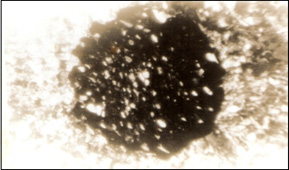
Along with stretching of quartz and feldspars, rotation of garnets present within phyllite, with broken margin and ‘S’ trail of inclusions (Figure 3a), further support existence of a non co-axial shearing and obviously a ductile regime. The greenish phyllite, in vicinity of the ore zone, becomes pinkish in colour and is rich in sericite/mica, locally turning into quartz-mica schist/gneiss. Pink felspathization is widely noticeable on either side of the ore bands. Phyllite, along the contact, is friable and comprises quartz, mica, chlorite, biotite and calcite (ankerite?) with minor amount of plagioclase, garnet, sphene, ottrelite (Mn-rich chloritoid), apatite and tourmaline. Occurrence of sphene, apatite and tourmaline, likewise, is more pronounce in vicinity of ore bodies. Within the mylonite zones, preferred orientation of the constituents along ‘S’ and ‘C’ surfaces is reported by Banerji DC et al. [6]. Also, elsewhere within the shear zone where ore bodies are absent, when traversed by pink feldspar bearing quartzo-felspathic veins, phyllite becomes richer in sericite and/or mica, pinkish in colour, and show occasional enrichment of brown-red garnet.
Figure 3b: Stretching of quartz and opaques within manganiferous quartzose band. X10, Tirodi mines.

Figure 3c: Photomicrograph showing preferred orientation and rotation of manganese opaques (upper left hand corner), and alignment of quartz, apatite and tourmaline along ‘S’ and ‘C’ planes. Crossed nicols, X32, Ukwa mines.
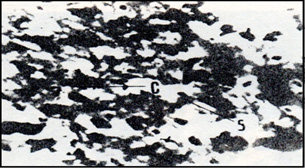
The composition of the quartz-mica/sericite schists enveloping the ore bodies at Ramrama, Tirodi and Sukli-Sitapathore, where phyllite is absent, has striking similarity with the sericite schists enveloping Ukwa and Bharweli deposits. Quartz-mica schists of the granite hosted deposits comprise quartz, muscovite, chlorite, sericite, altered potash feldspars, and accessory amount of garnet, tourmaline, apatite, kyanite, fibrolite and Mn opaques. Banerji DC [8] has claimed that muscovite / sericite present in vicinity of the ore zone is alteration product of potash feldspars, and the occurrence of clusters of tourmaline along fractures of quartz grains of the sericite schists is indicative of boron metasomatism in these high strain zones. Also, that, muscovitisation/sericitization of feldspars, boron metasomatism, and the presence of chlorite in association of fibrolite, indicate griesening along the ore zones, resulting finally into the formation of quartz-mica schists representing ‘Greisen’. The associated quartz is often stretched and the opaques are dimensionally oriented along ‘S’ and ‘C’ planes (Figure 3b & 3c), indicating progressive ductile deformation along the mylonites. Occurrence of well-developed and oriented crystals of tourmaline, apatite and fibrolite in the peripheral part of ore zones, in all the deposits, is also indicative of existence of a stress field. Pinching and swelling of the tongues of ore bodies, as shown in figure 2e above, is also a definitive manifestation of stress along the ore zone.
Characteristics of the Manganese Ore Bodies
Within the phyllitic host, the inter-layered manganese ore bodies of Sausar belt of Madhya Pradesh comprise manganeseoxides like braunite, bixbyite and hollandite as essential constituents and accessories like manganite, cryptomelane with psilomelane, and occur inter-banded with quartzose bands having inclusion of oriented grains of Mn opaques, sericitised pink feldspars, apatite and tourmaline, In addition, the biotite gneiss hosted deposits contain jacobsite, hausmanite, tirodite (Mnamphibole) and vredenburgite. Intergrowth textures, indicating a high temperature regime, between braunite and bixbyite, and between hausmanite and jacobsite along with the inclusion of vredenburgite in braunite and hausmanite in vredenburgite is well known. The work of Roy S [3,10,12-14], carried out in the field of Indian Manganese deposits, is unparallel, especially in the field of ore petrography. However, Roy like all other previous workers, assumed that Manganese mineralization associated with Sausar Group of rocks is metamorphosed syngenetic type, owing to their intimate association and co-folding with quartz-muscovite schists of Mansar Formation. Inter-banding of the ore inter-layers with quartzose bands has been taken as primary bedding. Roy S [15] advocated the elongation of the ore minerals as an effect of metamorphism accompanying deformation. Roy S [15], though, mentions the presence of strained, shattered and deformed grains of ore minerals in the ore body, he probably visualised a ‘strain insensitive fabric’ (or type II ‘S-C’ fabric of Lister GS et al. [16]), that is expected to form in all metamorphic grades and do not track the finite strain ellipsoid during non co-axial progressive deformation.
Figure 3d: The polished section of x200 magnification clearly shows a strain sensitive S-C fabric exhibited by braunite and holllandite grains. Bharweli mines. Reproduced figure 7 of Roy S [15].

This work, on the contrary, supports the presence of a ‘strain sensitive fabric’ (or the Type I ‘S-C’ fabric of Lister GS et al. [16]) as an invariable texture element of all the manganese deposits associated with Sausar Group of rocks of Madhya Pradesh. Though, the angle between the two planes along which the constituent minerals are aligned, is only about 200-300 (Figure 3C), clear indication of rotation of obliquely running planes, along which many of the grains are aligned, towards the horizontal plane is very glaring. The minerals aligned along the oblique planes got rotated with the finite strain ellipsoid, towards the horizontally aligned planes/ minerals those are arranged parallel to the boundary of the shear zone, demarcating a ‘mylonitic foliation’ or the ‘C’ plane, during the progressive ‘simple shear’. The oblique running rotated planes are obviously ‘S’ planes. Many of the figures illustrated in the work of Roy S [3,15], one of which is reproduced here for ready reference (Figure 3d), also exhibit this rotational feature. Accordingly, rotation of garnets with ‘S’ trail of inclusion and broken margin (Figure 3a) is explained here as metasomatic crystallization and further rotation, in a ductile state, due to progressive deformation related to simple shear, and not related to crystallization in quiet condition and rolling due to almandine grade of regional metamorphism accompanying deformation, as explained by Roy S [15].
Figure 3e: Photomicrograph showing preferred orientation and rotation of manganese opaques (lower right hand corner) and accessories. Crossed nicols, X32, Ukwa mines.
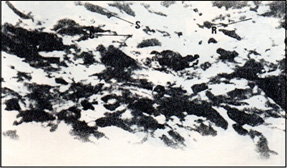
Figure 3f: Clustering of tourmaline along fractures of quartz grains, crossed nicols, Tirodi Mines. X 32.
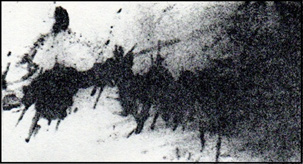
The assumption towards sedimentary origin of Manganese deposits associated with Sausars, has already been contested by Banerji DC et al. [6], and Banerji DC [8]. The present paper also, as already narrated in the earlier paragraphs, contests the idea of sedimentary deposition of the manganese ore bodies associated with the Sausar Group of rocks of Madhya Pradesh. The existence of high temperature regime, as indicated by the intergrowth textures of different manganese ore minerals, within host phyllite of green schist facies is a major misfit in the earlier theory, needing complex process of evolution of the deposit. Though, intense deformational forces producing elongation and preferred dimensional orientation of opaques has been discussed by Roy S [15], presence of oriented and rotated manganese opaques in the ore zone (Figure 3c and 3e), along with well-developed and oriented crystals of accessories like quartz, apatite, tourmaline and fibrolite along ‘S’ and ‘C’ planes and the resultant ‘strain sensitive fabric’, indicating that the ore bodies in all the deposits have undergone strong ductile deformation, has not been envisaged by earlier workers. Presence of clusters of tourmaline within the fractures of quartz grains (Figure 3f), and the well-developed crystals of apatite, indicate later metasomatic emplacement.
Presence of high temperature ore minerals and intergrowth textures have been explained earlier by bringing in complex evolutionary theory for the manganese deposits, and the reason for their plotting in hydrothermal field of “Mn-Fe-(Ni+Co+Cu) X 10 plots” has been explained lately by imagination of ‘submarine exhalates’ as the source for supply of ore minerals. This thought process, however, ignored any critical study of the field set-up of the ore deposits. In absence of the concept of shear parallel banding and compositional layering, and in paucity of good cross sections, non-coplanar nature of the ore bodies went unnoticed. Shear parallel compositional layers have been misinterpreted as sedimentary layering and co-axial nature of the ore bands with regional schistosity, on ground surface, has been taken for granted in support of the sedimentary origin of the ore bodies. Presence of griesens, enveloping the ore zones, played further havoc as they have been mistaken for metapelites, accompanying the misinterpreted ‘quartzose bands’ for sedimentary quartzites/chert bands. The quartzose inter-bands associated with the manganese ore inter-layers, as has been narrated elsewhere in this paper, cut across the S1 foliation and, hence, cannot be considered as of sedimentary origin. Furthermore, absence of any other member of the Sausar Group with the granite hosted deposits, excepting the enveloping ‘griesens’ (mistaken as Mansar schists), have been wrongly interpreted as ‘available narrow furrows’ to allow only manganese ore bands and the so called Mansar schists, within it. The glaring tongues of the ore bodies with pinch and swell nature, in wall rocks of the mines, have been ignored or went unnoticed.
It is not very complex to visualise hydrothermal veins, carrying manganese oxides, getting emplaced along the available post S1 weak zones cutting across the S1 planes. The late D1 shearing in the Sausar belt, and generation of shear (SH) planes, is well explained by Banerji DC et al. [6]. The block diagrams explaining the interrelationship between the different planes are reproduced here for the sake of making it handy (Figure 3g & 3h).
Figure 3g & h: (left) and 3h (right). Thematic block diagram showing structural evolution of the Sausar rocks of Balaghat area (reproduced from Banerji DC et al. [6]). (g) Initial development of plunging F1 folds (dotted lines) and development of co-axial, non coplanar shear planes SH (three broken lines). (h) Development of F2 folds and co-folding of shear planes/zone. F3 folds are also superimposed to represent the map pattern.

Presence of manganese silicates (manganese rich amphiboles, pyroxenes, garnet etc.) and manganese carbonates at the contact of ore inter-layers are explained, by earlier workers, to be because of metamorphism. The fact that the grade of metamorphism of Sausar rocks increases towards NW, has been taken as supportive evidence towards absence and presence of certain manganese oxides and silicates in Bharweli and other north-western deposits respectively. However, presence of intergrowth texture and inclusion of one constituent into the other, along with the veins of one constituent cutting across the other, in a surrounding of low grade rocks, remains less understood.
Visualization of emplacement of manganese-oxide bearing hydrothermal veins along weak zones makes it easy to understand the possible reaction that may take place between manganese oxides and the calcareous or siliceous host rocks, and/or the rocks like calc-silicates, to produce minerals like rhodochrosite, and tirodite, winchite, juddite (Mn amphiboles), rhodonite, Mndiopside, blanfordite (Mn-pyroxenes) along with spessartite and calcium bearing garnets respectively. The selective concentration of these silicates or carbonates or the garnets in vicinity of the contacts of different host rocks, then, is also well understood. The increasing regional metamorphism towards NW, also, might have played an additional roll in controlling the overall temperature of the contact zones.
Once the synkinematic emplacement of compositionally layered manganese-oxide bearing hydrothermal veins, along the post S1, coaxial but non coplanar (to S1) shear planes (SH) is visualised, understanding the nature of the inter-banded quartzose layers having similar non coplanar relationship with the S1 schistosity, as emplaced bands, is not difficult. Presence of ‘strain sensitive fabric’ elements both in the ore inter-layers and in quartzose bands further indicate prevalence of a ductile regime, conforming progressive simple shear along the shear zone. This, also, makes easy to understand the inter-layering within the ore zone as shear parallel compositional layers, having sharp contacts.
Banerji DC [8] has proposed that late D1 pink magmatism in the Sausar belt is responsible for generation of pink feldspar bearing pegmatites which got preferentially emplaced along the late D1 weak zones. Though, there were different generations of pink feldspar pegmatites, the initial pegmatities those followed the weak zones synkinematically, and developed distinct shear parallel compositional layering, had quartz rich bands occupying central part and feldspar rich layers occupying the flanks. Large scale boron metasomatism, developing schorl rock at local scale, and greisening, exemplified by the presence of mica rich flanks containing tourmaline and apatite, are common in all such layered pegmatites (also see Banerji DC et al. [7]). This phenomenon supports ‘pneumatolysis’ caused by hot volatiles, rich in boron fluorides, accompanying the igneous activity.
Likewise, some of the earlier emplacements were rich in Mnoxides and had compositionally layered manganese rich bands in the core, alternating with bands of quartz, and the flanks of such interbanded manganese ore bodies being occupied by altered feldspar and tourmaline rich quartz-mica schists, with clear indication of boron metasomatism, as exemplified by the presence of tourmaline along fractures of quartz grains (Figure 3f). Felspathization (pink feldspars) of the host rocks along with hydrothermal alteration makes the country rocks like green phyllite and biotite gneiss richer in white mica and altered pink feldspars, in vicinity of the ore bodies. Thus, it is quite befitting to equate the emplaced, noncoplanar to S1 schistosity, manganese ore inter-layers associated with the enveloping quartz-mica schists, with the layered / zoned pegmatitites occupying the weak zones, elsewhere in the Sausar belt. The banding and/or layering in the ore zone is obviously shear parallel layering / zoning.
There are later, post kinematic, pink feldspar bearing pegmatites, criss-crossing the ore inter-layers, containing manganese silicates like winchite and spessartite, well established by the earlier workers to have formed by interaction between pre-existing Mnoxides and quartzo-felspathic material. This phenomenon can be used to explain the ‘Gondites’ occurring closely associated with the ore deposits of Sukli Mines where presence of lot many calc-silicate bands, as enclaves within the host ‘Tirodi biotite gneiss’, come in close contact with the ore bands. In Sukli, a complex hard and brownish rock containing quartz, spessartite, rhodonite and other manganese silicates, along with few specks of manganese oxide ores, appear at the contact, wherever the ore inter-layers are directly in contact with the calc-silicate enclaves. Though, the ‘Gondites’ have been taken as parent rock for the associated manganese ore bodies, by many of the earlier workers, the present work suggests that the ‘Gondites’ actually came into existence at a later date, by a complex reaction between the manganese inter-bands and the calcsilicate rocks, giving rise to ca-rich manganese garnets and other Mn-Al silicates. The availability of the felspathic component along the contact is confirmed by pink felspathization of the host rocks along the contact zone. So far as the source of manganese in the hydrothermal veins is concerned, the inference made by Banerji DC [8] that the hydrothermal fluid, related to late D1 pink magmatism, was either rich in residual manganese, or, scavenged manganese oxides from the silicates of the host rocks, including calc-silicates, is found to be tenable and more befitting.
Roy S [14] has proposed that introduction of Photosystem II, and decrease of the oxygen sinks, led to a limited buildup of surface O2 during the Late Archean (2.75 Ga) period, and initiated modest deposition of manganese in shallow basin-margin oxygenated niches, in case of deposits associated with Sausar rocks, in India. Nevertheless, it appears too speculative and premature at this stage to assume other possibilities of enrichment of manganese in the hydrothermal veins, especially when the ore bearing hydrothermal emplacements have a direct link with the pink magmatism in the Sausar belt, and consequent enrichment of residual manganese is the logical possibility, the scavenging of manganese from the country rocks, largely calcareous in nature, could be an alternative. The possibility of scavenging is especially relevant as Sausar Group calc-silicates are found to be piedmontite bearing in low and medium grade varieties (Banerji DC et al. [11]), the amphiboles and pyroxenes of higher-grade varieties, thus, also are expected to carry manganese, and become richer in spessartite and other manganese silicates when intruded/assimilated by hydrothermal emplacements.
Discussion and Conclusion
In contrast to the earlier view of a ‘sedimentary origin’ for the manganese ore deposits associated with the Sausar Group of rocks in Madhya Pradesh, a theory of ‘epigenetic origin’ was highlighted for the first time by Banerji DC et al. [6].
The present paper further elaborates on the findings such as
A. invariable association of shear zones with the manganese deposits of Madhya Pradesh and, at least, with one of the deposits (Mansar-Kandri) of adjoining state of Maharashtra,
B. ductile deformation of all the ore bodies as exemplified by the micro ‘S-C’ structures shown by its mineral constituents,
C. pinch and swell arrangement of the ore bodies,
D. presence of tongues of ore bodies in wall rocks of Tirodi mines with swerving around foliation in host ‘Tirodi biotite gneiss’ along the bulges of tongues of the ores, and
E. the non coplanar (cutting across) relationship of the ore inter-layers with the S1 foliation of the host phyllite, in Bharweli Mines. These findings, well depicted by the supportive figures, speak of a structurally controlled epigenetic emplacement of the ore bodies, having undergone ductile deformation, within the Sausar Group of rocks.
Moreover, the evidences like large scale felspathisation (pink) of the country rocks and pneumatolysis along the flanks of the ore zones also support for igneous activity (emplacement) preceding the movement of gaseous boron fluoride (as evidenced by the presence of tourmaline and apatite) along the flanks of the ore bodies, within the high strain zones. Hydrothermal emplacement of manganese ore bodies, along weak zones, has also been advocated for granite hosted New Ross manganese deposits of Canada (Reily GAO [17]), and for the phyllite hosted, strike parallel, Northern Nigerian manganese occurrences (Mucke A et al. [18]).
The evidences like, manganese ore inter-bands being co-axial but non coplanar to the S1 schistosity of the country rock, their being coplanar to the shear planes, and co-folding of the ore bodies and the shear planes along S2 and S3 axial traces, is affirmative to the timing of shearing and emplacement of ore bodies, and points to the fact that the Sausar rocks were affected by co-axial (S1) but non coplanar shearing and hydrothermal emplacements, at the waning phase of the first deformation (D1) causing generation of S1 schistosity. This model of structurally controlled hydrothermal emplacement also successfully explains the presence of ore bodies within calcareous members of the Sausar Group, like Lohangi or Bichua metacarbonates, as discussed elsewhere in the paper.
It goes without saying that the ore petrography carried out by Roy S [3] did not, directly, support a sedimentary origin for the manganese ores deposits of Madhya Pradesh. It, rather, required support of complex theory to prove that the original deposit could have been sedimentary. The entire ore petrology, as depicted by Roy S [3], if taken in support of an igneous origin, does not require any other explanation for the presence of high temperature ore minerals and their ‘more akin to’ igneous textures. Plotting of the manganese ore samples, from Madhya Pradesh deposits, in hydrothermal field of “Mn-Fe-(Ni+Co+Cu) X 10 plots”, as reported by Nayak BK et al. [4], is directly affirmative to hydrothermal emplacements of the ore bodies along the weak planes, as explained above.
References
- Fermor LL (1909) The manganese ore deposits of India. Mem Geol Surv 37(4): 613-1287.
- Straczek JA, Narayanaswami S, Subramanyam MR, Shukla KD, Vemban NA, et al. (1956) Manganese ore deposits of Madhya Pradesh, India. 20th Int Geol Cong, Mexico Session, Symposium on Manganese, Mexico, 4: 63-96.
- Roy S (1966) Syngenetic manganese formations of India. Jadavpur University, Calcutta.
- Nayak BK, Acharya BC, Sahu RK (1995) Factor model for the genesis of manganese deposit, Balaghat, MP. Jour Geol Soc Ind 46(1): 65-73.
- Banerji DC, Shrivastava RK, Fulmari M, Singhai RK, Devrajan MK, et al. (1996) Final report on special thematic mapping of Sausar belt in parts of Balaghat and Seoni districts of Madhya Pradesh. Geol Surv Ind unpublished progress report.
- Banerji DC, Majumder S, Singhai RK, Shrivastava RK, Fulmari M (2007) Manganese mineralization associated with folded shear zones in Balaghat district, Madhya Pradesh. Jour Eco Geo and Georesource Management 4(1-2): 128-141.
- Banerji DC, Majumder S, Shrivastava RK, Fulmari M, Basu AK (2019) Hierarchy amongst rocks of Sausar group-evidences from seoni-balaghat area, Madhya Pradesh, India. Arch & Anthropol Open Acc 3(4): 515-534.
- Banerji DC (2020) Evidences towards hydrothermal origin of manganese deposits of Sukli-Sitapathore-Tirodi-Ramrama-Bharweli-Ukwa Belt of Madhya Pradesh, India. Nov Res Sci 5(2): 1-6.
- Narayanaswamy S, Chakravarty SC, Vemban NA, Shukla KD, Subramanyam MR, et al. (1963) The geology and manganese ore deposits of the manganese belt in Madhya Pradesh and adjoining parts of Maharashtra. Bull Geol Surv Ind Ser A, Manager of Publications, Civil Lines, India.
- Roy S (1997) Genetic diversity of manganese deposition in the terrestrial geological record. Geological Society, Special Publications, London, UK, pp. 5-27.
- Banerji DC, Majumder S, Shrivastava RK, Fulmari M, Adhir KB (2018) Contact metamorphism of calcareous metasediments of Sausars from Western Balaghat area of Madhya Pradesh, India and its implication in Sausar stratigraphy. Arch & Anthropol Open Acc 3(4): 48-426.
- Roy S (1970) Studies on manganese bearing silicate minerals from metamorphosed manganese formations of India I Juddite. Min Mag 37(290): 708-716.
- Roy S (1980) Geology and geochemistry of manganese, Manganese deposits of continents. Volume II, Academic Publisher, Hungary, pp. 236-264.
- Roy S (2006) Sedimentary manganese metallogenesis in response to the evolution of the earth system. Earth-Science Review 77(4): 273-305.
- Roy S (1962) Study of the metamorphic manganese ores of Bharweli mine area, Madhya Pradesh, India, and their genesis. Econ Geol 57(2): 195-208.
- Lister GS, Snoke AW (1984) S-C Mylonites. Journal of Structural Geology 6(6): 617-638.
- Reilly GAO (1992) Petrographic and geochemical evidences for a hypogene origin of granite hosted, vein type Mn mineralisation at the New Ross Mn deposits, Lunenberg country, Nova Scotia, Canada. Econ Geol 87(5): 1275-1300.
- Mucke A, Okujeni C (1984) Geological and ore microscopic evidence on the epigenetic origin of the manganese occurrences in northern Nigeria. Journal of African Earth Sciences 2(3):209-225.
© 2022 Banerji DC. This is an open access article distributed under the terms of the Creative Commons Attribution License , which permits unrestricted use, distribution, and build upon your work non-commercially.
 a Creative Commons Attribution 4.0 International License. Based on a work at www.crimsonpublishers.com.
Best viewed in
a Creative Commons Attribution 4.0 International License. Based on a work at www.crimsonpublishers.com.
Best viewed in 







.jpg)






























 Editorial Board Registrations
Editorial Board Registrations Submit your Article
Submit your Article Refer a Friend
Refer a Friend Advertise With Us
Advertise With Us
.jpg)






.jpg)














.bmp)
.jpg)
.png)
.jpg)










.jpg)






.png)

.png)



.png)






